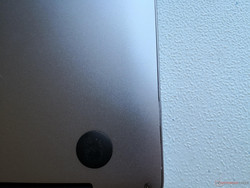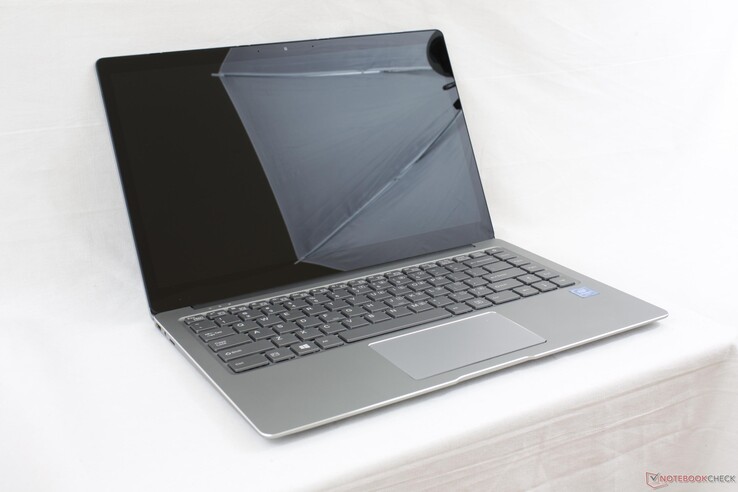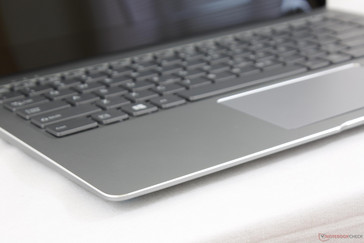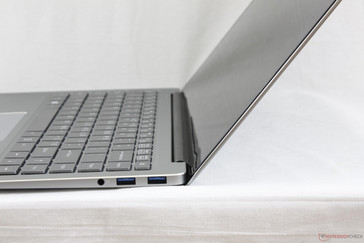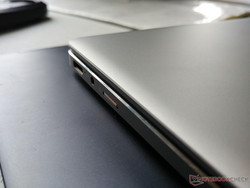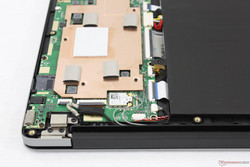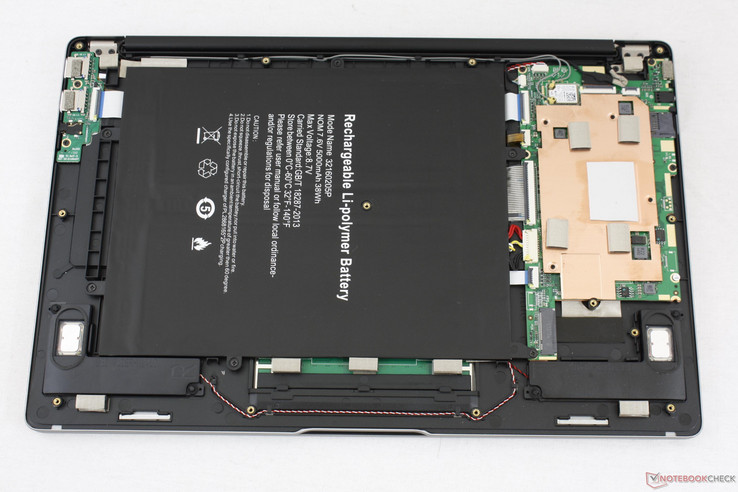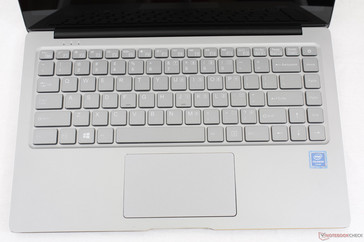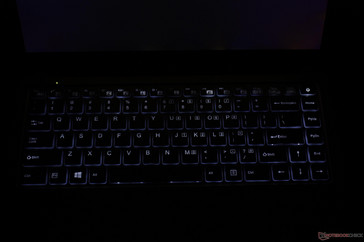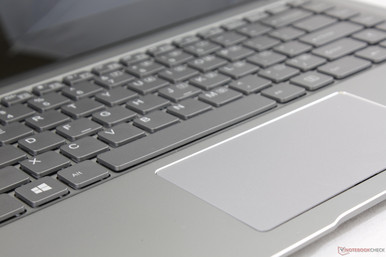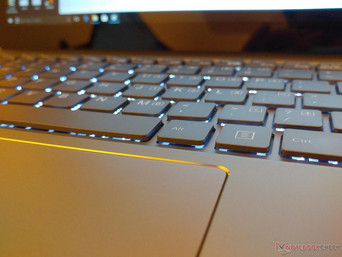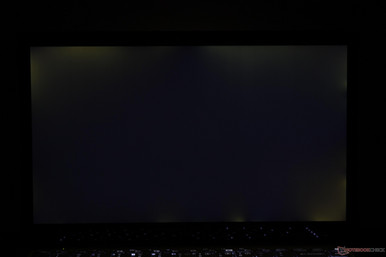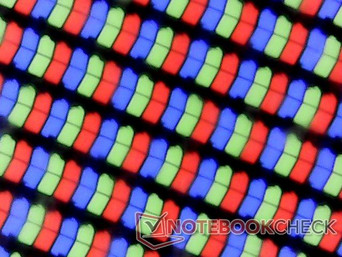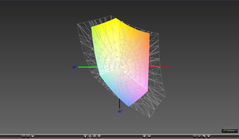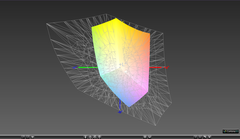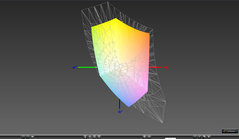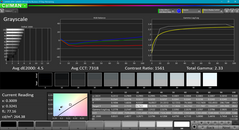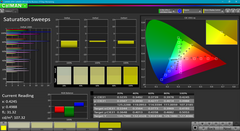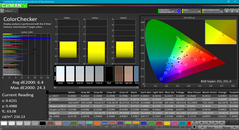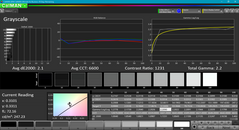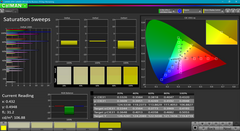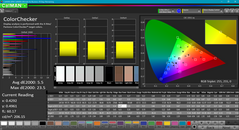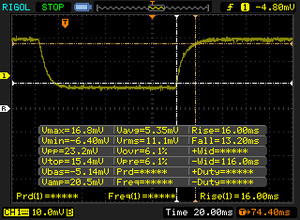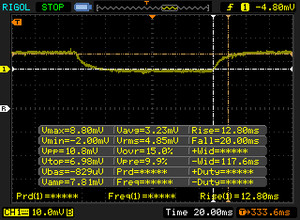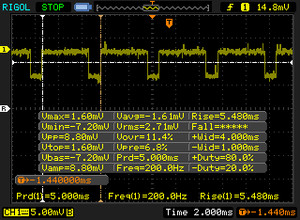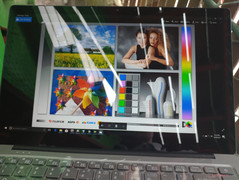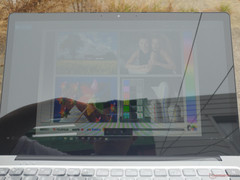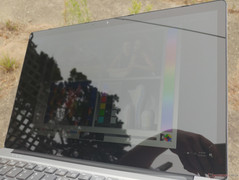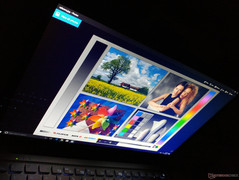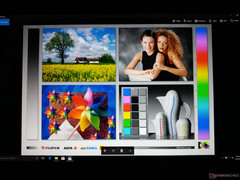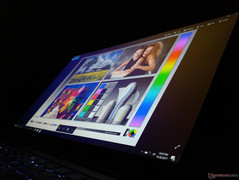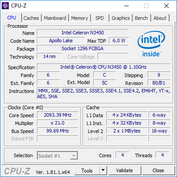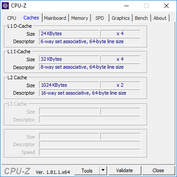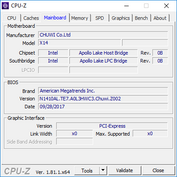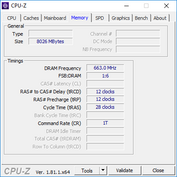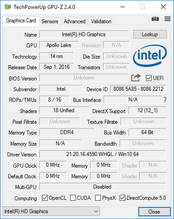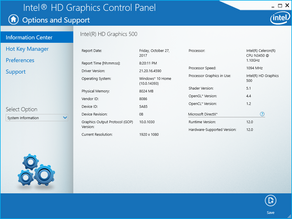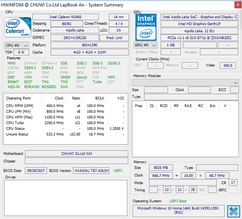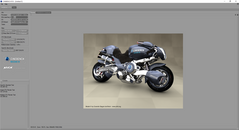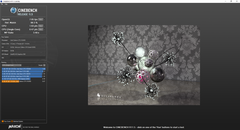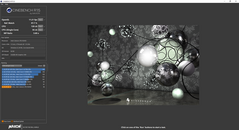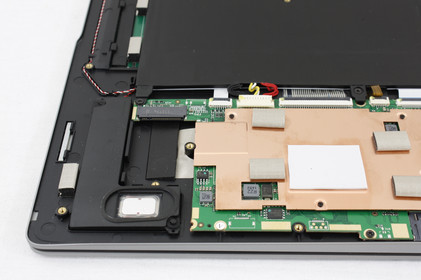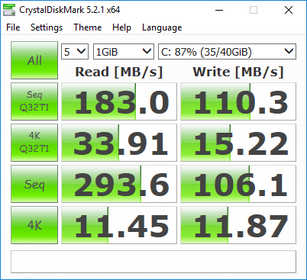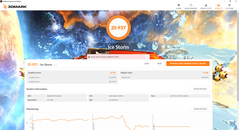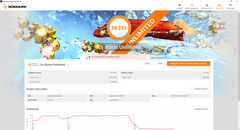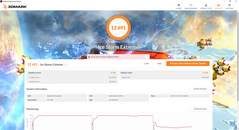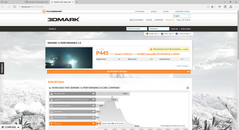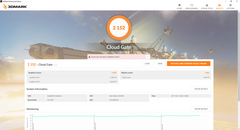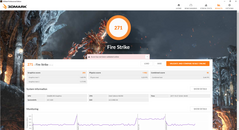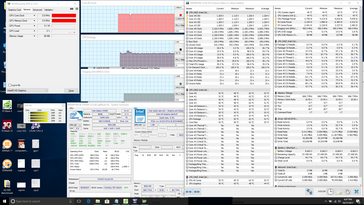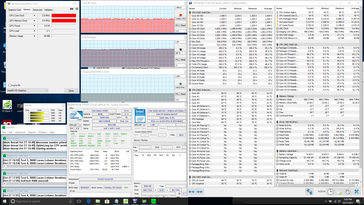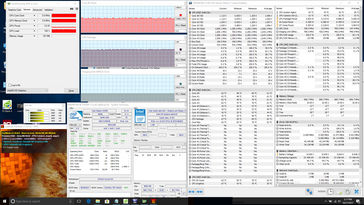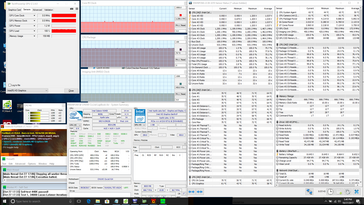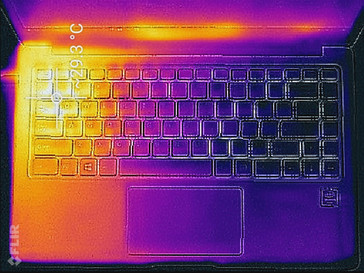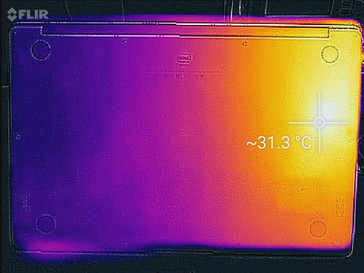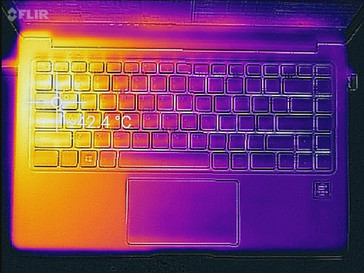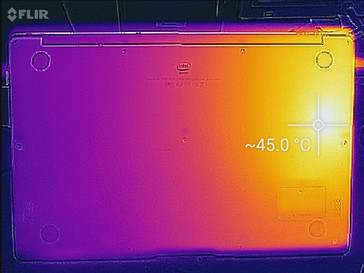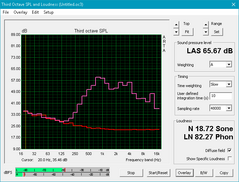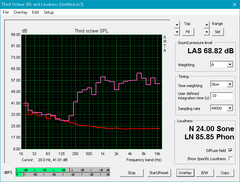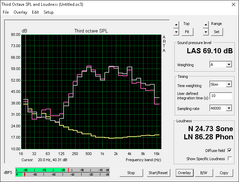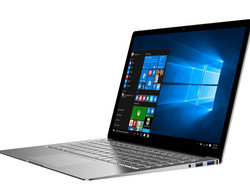Chuwi LapBook Air 14.1 (N3450, FHD) Laptop Review

Chuwi only recently dived into the world of laptops after having released a string of affordable Android and Windows tablets. In keeping with its tradition of a budget-oriented product line, the new LapBook series of super-thin notebooks is home to very affordable products inspired by the designs of costlier flagship Ultrabooks. The MacBook Air, for example, was an obvious source of inspiration for the LapBook 12.3 and LapBook Air 14.1.
The LapBook 14.1 is currently available in two SKUs. The less expensive SKU with 4 GB of RAM, 64 GB eMMC, matte display, and plastic chassis retails for around $250 USD while the pricier LapBook Air 14.1 SKU doubles the RAM and storage with a glossy display and magnesium alloy chassis for around $400 USD. Either way, both configurations are equipped with the same quad-core Celeron N3450 CPU, integrated HD Graphics 500 GPU, FHD resolution panel, and connectivity features. Our test unit today is the latter configuration which is still quite the steal considering the very low asking price. Though attractive from the outside, we'll be scrutinizing the hardware to see what devils Chuwi may be hiding under the details.
Direct competitors include the HP Pavilion 14, Lenovo IdeaPad 320s, and Acer Aspire E5.
Case
If visual appeal was Chuwi's goal with the LapBook Air, then they have hit a home run. There's no denying that the gray Magnesium alloy design looks classier than the usual plastic notebooks in this price category. The chrome-cut edges shimmer under ambient lighting and the smooth matte surfaces are excellent at hiding fingerprints and grease. In comparison, the 14-inch Razer Blade utilizes an all-black black Magnesium alloy chassis that accentuates fingerprints from every angle. This is a flagship facade for a budget price.
Chassis quality is where the LapBook Air begins to show signs of cut corners. Simply adjusting the angle of the lid will cause audible creaking around the plastic hinge and our test unit has a slightly bent edge near the USB port as shown by our image to the right. Attempting to twist the lid and the chassis base will result in slight creaking as well. Otherwise, rigidity is actually very good for both the lid and base largely due to the glass screen reinforcement and CNC alloy material. Commonly weak areas of notebooks like the center of the keyboard or outer lid show minimal flexing when applying pressure.
In terms of size and weight, the portable LapBook is slightly lighter than competing budget alternatives including the Pavilion 14 and IdeaPad 320s. It's also about as light as the 13.3-inch MacBook Air while offering a larger 14-inch screen size. The chrome edges and corners around the base and lid make the LapBook appear thinner than it actually is when in reality the notebook is slightly thicker than the aforementioned HP and Lenovo alternatives.
Connectivity
Availabe ports are easy to reach on the left- and right-hand edges of the notebook. Perhaps annoyingly, there are no USB ports on the left side and most users will be needing a mini-HDMI to HDMI adapter to utilize the mini-HDMI port similar to the Jumper EZBook 3. The thicker HP Pavilion 14 incorporates more USB ports, a full-size HDMI port, a full-size SD reader, and a Gigabit Ethernet port for better connectivity.
We experienced a power delivery issue on one of two USB 3.0 ports on our test unit. Connecting an external storage drive would only work on one of the two ports as the other would constantly toggle our external storage drive on and off even after multiple tries.
SD Card Reader
Chuwi could have easily omitted a card reader altogether but has included a spring-loaded MicroSD slot for storage expansion. Transfer rates with our Toshiba THN-M401S0640E2 MicroSD card are slow at about 45 MB/s compared to almost twice that on the Samsung Notebook 9 when using the same MicroSD card. Transferring 1 GB worth of photos from the card to desktop takes about 27 seconds compared to under 9 seconds on the Dell XPS 13.
A fully inserted MicroSD card sits flush against the edge of the notebook as shown by the image to the right. While good for transporting, users with short nails and larger fingers will have a very tough time removing the card.
| SD Card Reader | |
| average JPG Copy Test (av. of 3 runs) | |
| Dell XPS 13 i7-8550U | |
| Samsung Notebook 9 NP900X3N-K01US | |
| Chuwi LapBook 14 inch 2017 | |
| maximum AS SSD Seq Read Test (1GB) | |
| Dell XPS 13 i7-8550U | |
| Samsung Notebook 9 NP900X3N-K01US | |
| Chuwi LapBook 14 inch 2017 | |
Communication
WLAN is provided by an Intel 3165 M.2 1216 module for 802.11ac and Bluetooth 4.2 connectivity. Real-world transfer rates when standing next to our Linksys EA8500 test router average just over 300 MB/s as expected from a 1x1 WLAN card. We experienced no reliability issues during our time with the test unit.
| Networking | |
| iperf3 transmit AX12 | |
| Dell XPS 13 i7-8550U | |
| Samsung Notebook 9 NP900X3N-K01US | |
| Chuwi LapBook 14 inch 2017 | |
| iperf3 receive AX12 | |
| Samsung Notebook 9 NP900X3N-K01US | |
| Dell XPS 13 i7-8550U | |
| Chuwi LapBook 14 inch 2017 | |
Accessories
There are no included extras outside of the Warranty card and Quick Start guide.
Maintenance
Warranty
The standard one-year limited warranty applies. Buyers are responsible for paying return shipping costs. Please see our Guarantees, Return Policies & Warranties FAQ for country-specific information.
Input Devices
Keyboard
The keyboard looks great at first glance. Its keys are large and travel appears deep because of how elevated the keys are from the base. In practice, however, feedback is soft and nowhere near as firm as on the Lenovo AccuType keyboard. The Enter and Space keys in particular feel spongier than on most other major Ultrabooks including on the XPS 13. The corner Ctrl key on our unit also malfunctioned during testing and lacks feedback completely. Users who intend to do lots of typing on the LapBook Air will need some time to become accustomed to the keyboard.
A one-level backlight is included for working in dimly lit conditions. While its luminosity is uneven across the keyboard as shown by our image below, the fact that a backlight is available at all in this price range should be appreciated.
Touchpad
The wide clickpad (11.0 x 6.5 cm) is large for the screen size and its surface is smooth to the touch. Unfortunately, the finger tends to stick when gliding very slowly and so smaller precision cursor movements are more difficult. Slight cursor jitters become apparent during slow movements as well. Multi-touch gestures of up to four fingers are otherwise responsive and reliable.
The integrated mouse keys are shallow and very spongy. Inputting a click demands a great deal of force from the user compared to the clickpads on other notebooks. As a result, the simple action of pressing down on the clickpad can be tiring especially if clicking in rapid succession.
Display
The LapBook Air comes standard with a glossy 1080p IPS display and no touchscreen options. The BOE06A8 panel can be found on no other notebook in our database. Its backlight is bright enough for indoor environments but is merely average for its size class at 243 nits. The display on the Samsung Notebook 9, for example, is nearly twice as bright at 481 nits. Contrast and display response times are good considering the price but average compared to flagship Ultrabooks.
Subjectively, onscreen text is sharp and colors pop due to the thin edge-to-edge glass overlay. Unfortunately, the panel suffers from PWM when the brightness level is set to 20 percent or lower. Our specific unit also suffers from moderate-heavy backlight bleeding around the edges and corners that is common amongst budget notebooks.
| |||||||||||||||||||||||||
Brightness Distribution: 92 %
Center on Battery: 247.7 cd/m²
Contrast: 774:1 (Black: 0.32 cd/m²)
ΔE Color 6.4 | 0.5-29.43 Ø5
ΔE Greyscale 4.5 | 0.57-98 Ø5.3
62.9% sRGB (Argyll 1.6.3 3D)
39.8% AdobeRGB 1998 (Argyll 1.6.3 3D)
43.93% AdobeRGB 1998 (Argyll 2.2.0 3D)
63.6% sRGB (Argyll 2.2.0 3D)
42.53% Display P3 (Argyll 2.2.0 3D)
Gamma: 2.33
| Chuwi LapBook 14 inch 2017 Name: BOE06A8, IPS, 14.10, 1920x1080 | Lenovo Ideapad 110S-11IBR Chi Mei CMN1132, TN LED, 11.60, 1366x768 | Jumper EZbook 3 MS_9003, TN LED, 14.10, 1920x1080 | HP Pavilion 14-al103ng AU Optronics, IPS, 14.00, 1920x1080 | Apple MacBook Air 13 inch 2015-03 Apple APP9CF0, TN LED, 13.30, 1440x900 | |
|---|---|---|---|---|---|
| Display | 1% | 21% | -14% | -6% | |
| Display P3 Coverage | 42.53 | 42.77 1% | 51.6 21% | 36.58 -14% | 40.1 -6% |
| sRGB Coverage | 63.6 | 64.2 1% | 77.3 22% | 54.9 -14% | 59.8 -6% |
| AdobeRGB 1998 Coverage | 43.93 | 44.2 1% | 53 21% | 37.79 -14% | 41.51 -6% |
| Response Times | 4247% | 7% | -27% | ||
| Response Time Grey 50% / Grey 80% * | 32.8 ? | 46 ? -40% | 46 ? -40% | 53 ? -62% | |
| Response Time Black / White * | 29.2 ? | 30 ? -3% | 11.6 ? 60% | 27 ? 8% | |
| PWM Frequency | 200 ? | 25770 ? 12785% | 200 ? 0% | ||
| Screen | -29% | -54% | 16% | 15% | |
| Brightness middle | 247.7 | 243 -2% | 384 55% | 200 -19% | 329 33% |
| Brightness | 243 | 230 -5% | 341 40% | 191 -21% | 310 28% |
| Brightness Distribution | 92 | 91 -1% | 76 -17% | 90 -2% | 82 -11% |
| Black Level * | 0.32 | 0.4 -25% | 1.28 -300% | 0.14 56% | 0.405 -27% |
| Contrast | 774 | 608 -21% | 300 -61% | 1429 85% | 812 5% |
| Colorchecker dE 2000 * | 6.4 | 11.24 -76% | 8.7 -36% | 5.06 21% | 3.96 38% |
| Colorchecker dE 2000 max. * | 24.3 | 19.82 18% | 16.7 31% | 10.91 55% | 7.51 69% |
| Greyscale dE 2000 * | 4.5 | 12.78 -184% | 11.1 -147% | 3.94 12% | 3.51 22% |
| Gamma | 2.33 94% | 2.33 94% | 2.2 100% | 2.41 91% | 3.83 57% |
| CCT | 7318 89% | 15436 42% | 12445 52% | 6159 106% | 6711 97% |
| Color Space (Percent of AdobeRGB 1998) | 39.8 | 41 3% | 35 -12% | 38.4 -4% | |
| Color Space (Percent of sRGB) | 62.9 | 64 2% | 55 -13% | 59.8 -5% | |
| Total Average (Program / Settings) | 1406% /
778% | -9% /
-25% | -8% /
4% | 5% /
10% |
* ... smaller is better
Color space is approximately 40 percent and 63 percent of the AdobeRGB and sRGB standards, respectively. This is very common amongst older or lower-end panels like on the HP Pavilion 14. Flagship Ultrabooks like the Zenbook 3 or Yoga 920 cover much more of sRGB for deeper and potentially more accurate colors.
Further measurements with an X-Rite spectrophotometer reveal inaccurate colors and grayscale out of the box. Our calibration efforts improve grayscale by lowering the color temperature, but colors are still generally inaccurate especially at higher saturation levels where the limited color space takes its toll. Pure Red, for example, appears Red-orange and Blue appears more Blue-violet. Blue and Magenta colors in particular are not reproduced as accurately as the other colors.
Display Response Times
| ↔ Response Time Black to White | ||
|---|---|---|
| 29.2 ms ... rise ↗ and fall ↘ combined | ↗ 16 ms rise | |
| ↘ 13.2 ms fall | ||
| The screen shows relatively slow response rates in our tests and may be too slow for gamers. In comparison, all tested devices range from 0.1 (minimum) to 240 (maximum) ms. » 75 % of all devices are better. This means that the measured response time is worse than the average of all tested devices (21.5 ms). | ||
| ↔ Response Time 50% Grey to 80% Grey | ||
| 32.8 ms ... rise ↗ and fall ↘ combined | ↗ 12.8 ms rise | |
| ↘ 20 ms fall | ||
| The screen shows slow response rates in our tests and will be unsatisfactory for gamers. In comparison, all tested devices range from 0.2 (minimum) to 636 (maximum) ms. » 38 % of all devices are better. This means that the measured response time is similar to the average of all tested devices (33.7 ms). | ||
Screen Flickering / PWM (Pulse-Width Modulation)
| Screen flickering / PWM detected | 200 Hz | ≤ 20 % brightness setting | |
The display backlight flickers at 200 Hz (worst case, e.g., utilizing PWM) Flickering detected at a brightness setting of 20 % and below. There should be no flickering or PWM above this brightness setting. The frequency of 200 Hz is relatively low, so sensitive users will likely notice flickering and experience eyestrain at the stated brightness setting and below. In comparison: 53 % of all tested devices do not use PWM to dim the display. If PWM was detected, an average of 17903 (minimum: 5 - maximum: 3846000) Hz was measured. | |||
Outdoor visibility is average at best when under shade, but the screen is far too dim when under sunlight or a clear sky. The backlight is not powerful enough to overcome glare from the glossy screen and so users will be constantly adjusting the display to minimize glare. Luckily, the IPS panel allows for very wide viewing angles with only slight blue-violet tints if viewing from extreme angles.
Performance
No other CPU, GPU, or display options are available for the LapBook Air 14.1. The 6 W Apollo Lake Celeron N3450 is uncommon but can be found on very inexpensive notebooks including on the Acer Spin 1 and Chuwi's own LapBook 12.3. RAM is soldered and fixed at 8 GB DDR3L.
Processor
Raw CPU performance is very similar to that of the Atom x5-Z8550. This is bottom-of-the-barrel as even a lowly Core i3-6100U is over twice as fast according to CineBench benchmarks. Even the AMD A9-9420, which we blasted for its slow processor performance, runs objectively faster than our Celeron N3450.
The CPU is otherwise steady when under stress. Running CineBench R15 Multi-Thread in a loop results in uniform scores over time.
| wPrime 2.10 - 1024m | |
| Chuwi LapBook 14 inch 2017 | |
| Lenovo IdeaPad Z40-59422614 | |
| HP 15-bw077ax | |
| Lenovo Thinkpad 13-20J1001BUS | |
| HP Pavilion 15z-bw000 | |
* ... smaller is better
System Performance
PCMark benchmarks rank the Chuwi far below more common and pricier alternatives like the MacBook Air 13. Subjectively, installations and launching applications take much longer to complete and are nowhere near as instantaneous as Core ix-based Ultrabooks.
We experienced at least two crashes when attempting to restart the system and when waking up from Sleep. Our unit also had problems installing the latest Windows 10 updates and required multiple tries.
| PCMark 8 | |
| Home Score Accelerated v2 | |
| Acer Swift 3 SF315-51G-57E5 | |
| Apple MacBook Air 13 inch 2015-03 | |
| Chuwi LapBook 14 inch 2017 | |
| Lenovo Yoga Book 2016 Windows 64GB LTE | |
| Work Score Accelerated v2 | |
| Acer Swift 3 SF315-51G-57E5 | |
| Apple MacBook Air 13 inch 2015-03 | |
| Chuwi LapBook 14 inch 2017 | |
| Lenovo Yoga Book 2016 Windows 64GB LTE | |
| Creative Score Accelerated v2 | |
| Acer Swift 3 SF315-51G-57E5 | |
| Apple MacBook Air 13 inch 2015-03 | |
| Chuwi LapBook 14 inch 2017 | |
| PCMark 8 Home Score Accelerated v2 | 1682 points | |
| PCMark 8 Creative Score Accelerated v2 | 1952 points | |
| PCMark 8 Work Score Accelerated v2 | 2552 points | |
| PCMark 10 Score | 1243 points | |
Help | ||
Storage Devices
A soldered primary 128 GB SSD is included with an unoccupied M.2 2242 slot for expansion. This is a unique feature of the Chuwi notebook as most budget offerings and even major flagship ones do not offer secondary storage options.
Unfortunately, the primary drive is very slow by SSD standards. The SanDisk DF4128 in use is very similar to the SanDisk SSD in the Lenovo Ideapad 110S and both share nearly identical CrystalDiskMark scores. Sequential read rate is only 183 MB/s compared to 500+ MB/s on most newer SATA III SSDs. Even the SATA II SSD in the old Vizio laptop clocks in faster than this particular SanDisk SSD.
See our table of SSDs and HDDs for more benchmark comparisons. Both AS SSD and PCMark 8 Storage do not run successfully on our unit possibly due to to issues installing Microsoft's Net Framework.
| Chuwi LapBook 14 inch 2017 SanDisk DF4128 | Dell XPS 13 i7-8550U Toshiba XG5 KXG50ZNV256G | Samsung Notebook 9 NP900X3N-K01US Samsung CM871a MZNTY256HDHP | Lenovo Ideapad 110S-11IBR SanDisk DF4032 | Lenovo IdeaPad 320s-14IKB Samsung PM961 NVMe MZVLW128HEGR | |
|---|---|---|---|---|---|
| CrystalDiskMark 5.2 / 6 | 743% | 402% | -8% | 696% | |
| Write 4K | 11.87 | 121.5 924% | 105.4 788% | 13.87 17% | 127.9 978% |
| Read 4K | 11.45 | 24.92 118% | 34.45 201% | 12.23 7% | 42.82 274% |
| Write Seq | 106.1 | 345 225% | 458.4 332% | 101.7 -4% | 795 649% |
| Read Seq | 293.6 | 1313 347% | 489.4 67% | 165.1 -44% | 1056 260% |
| Write 4K Q32T1 | 15.22 | 346.1 2174% | 99.2 552% | 13.63 -10% | 176.8 1062% |
| Read 4K Q32T1 | 33.91 | 389.4 1048% | 273.5 707% | 36.23 7% | 322.4 851% |
| Write Seq Q32T1 | 110.3 | 334.7 203% | 512 364% | 94.8 -14% | 793 619% |
| Read Seq Q32T1 | 183 | 1840 905% | 551 201% | 147.5 -19% | 1782 874% |
GPU Performance
The integrated HD Graphics 500 is incapable of gaming and offers no appreciable performance benefits over the HD Graphics 400. 4K UHD playback, however, is now possible. Both 1080p60 and 2160p60 videos from YouTube play smoothly with no major dropped frames. Note that CPU utilization can be as high as 90 percent during 2160p playback with an average in the 50 to 70 percent range. As such, heavy multi-tasking during 4K UHD playback may not be the best idea.
See our dedicated GPU page on the HD Graphics 500 for more technical information and benchmark comparisons.
| 3DMark | |
| 1280x720 Cloud Gate Standard Graphics | |
| Intel NUC5i3RYK | |
| Acer Spin 5 SP513-51 | |
| Lenovo Thinkpad 13-20J1001BUS | |
| Fujitsu Lifebook U574 | |
| Lenovo Ideapad 320-17AST-80XW0013GE | |
| HP 15-bw075ax | |
| Jumper EZbook 3 | |
| Chuwi Lapbook 12.3 | |
| Chuwi LapBook 14 inch 2017 | |
| Lenovo Yoga Book 2016 Windows 64GB LTE | |
| Lenovo Miix 3 10 | |
| 1280x720 offscreen Ice Storm Unlimited Graphics Score | |
| Lenovo Thinkpad 13-20J1001BUS | |
| Lenovo Ideapad 320-17AST-80XW0013GE | |
| HP 15-bw075ax | |
| Chuwi Lapbook 12.3 | |
| Jumper EZbook 3 | |
| Chuwi LapBook 14 inch 2017 | |
| 3DMark 11 Performance | 445 points | |
| 3DMark Ice Storm Standard Score | 20937 points | |
| 3DMark Cloud Gate Standard Score | 2152 points | |
| 3DMark Fire Strike Score | 271 points | |
Help | ||
Stress Test
We stress the notebook with unrealistic processing loads to identify for any potential throttling or hardware issues. When under Prime95 stress, the CPU can be observed stabilizing in the 1.5 to 1.6 GHz range compared to its base clock rate of 1.1 GHz. Clock rate drops to 1.2 GHz whilst running Prime95 and FurMark simultaneously, which is impressively still above the base clock rate. Core temperature never climbs above 71 C.
Running on battery power will not impact CPU or GPU performance. A 3DMark 11 run on batteries returns Physics and Graphics scores of 1772 and 419 points, respectively, compared to 1823 and 390 points when on mains.
| CPU Clock (GHz) | GPU Clock (MHz) | Average CPU Temperature (°C) | |
| Prime95 Stress | 1.5 - 1.6 | -- | 68 |
| FurMark Stress | -- | 350 | 65 |
| Prime95 + FurMark Stress | 1.2 | 200 | 70 |
Emissions
System Noise
The cooling solution consists of a copper heat spreader in place of a fan and heat pipe. While fan noise is absent, we can identify very slight coil whine emanating from the left side of the notebook when under high processing load. The noise is generally inaudible when sitting at a normal distance away from the notebook and shouldn't be a distraction as a result.
Noise Level
| Idle |
| / / dB(A) |
| Load |
| / dB(A) |
 | ||
30 dB silent 40 dB(A) audible 50 dB(A) loud |
||
min: | ||
| Chuwi LapBook 14 inch 2017 HD Graphics 500, Celeron N3450, SanDisk DF4128 | Samsung Notebook 9 NP900X3N-K01US HD Graphics 620, i5-7200U, Samsung CM871a MZNTY256HDHP | Lenovo Ideapad 110S-11IBR HD Graphics 400 (Braswell), N3060, SanDisk DF4032 | Lenovo IdeaPad 320s-14IKB HD Graphics 610, Pentium 4415U, Samsung PM961 NVMe MZVLW128HEGR | Acer Swift 3 SF315-51G-57E5 GeForce MX150, i5-8250U, Hynix HFS128G39TND | Apple MacBook Air 13.3" 1.8 GHz (2017) HD Graphics 6000, 5350U, Apple SSD SM0128G | |
|---|---|---|---|---|---|---|
| Noise | ||||||
| off / environment * | 28.4 | 30.5 | ||||
| Idle Minimum * | 28.4 | 31.1 | 30.5 | |||
| Idle Average * | 28.4 | 31.1 | 30.5 | |||
| Idle Maximum * | 28.4 | 31.1 | 30.9 | |||
| Load Average * | 33.2 | 34.8 | 35.7 | |||
| Load Maximum * | 35.2 | 33.7 | 35.6 |
* ... smaller is better
Temperature
Hot spots are very localized as is common on passively-cooled notebooks. In this case, the left half of the notebook will always be noticeably warmer than the right because of the positioning of the motherboard. The left palm rest and WASD keys can be about 3 C to 4 C warmer than the right side even when idling on desktop. If not working on a flat table, the temperature variation may be of slight annoyance to users. Most other ultra-thin notebooks like the Spectre 13 have more symmetrical surface temperature development to reduce temperature disparities and improve user comfort.
(±) The maximum temperature on the upper side is 42.4 °C / 108 F, compared to the average of 35.9 °C / 97 F, ranging from 21.4 to 59 °C for the class Subnotebook.
(±) The bottom heats up to a maximum of 45 °C / 113 F, compared to the average of 39.4 °C / 103 F
(+) In idle usage, the average temperature for the upper side is 24.8 °C / 77 F, compared to the device average of 30.7 °C / 87 F.
(+) The palmrests and touchpad are reaching skin temperature as a maximum (35.2 °C / 95.4 F) and are therefore not hot.
(-) The average temperature of the palmrest area of similar devices was 28.3 °C / 82.9 F (-6.9 °C / -12.5 F).
Speakers
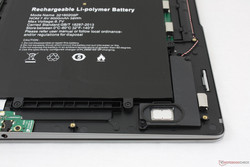
The integrated stereo speakers are unimpressive with tinny sound and poor bass reproduction not unlike on an inexpensive tablet. As our pink measurements below show, maximum volume could be louder and with better balance between bass and treble frequencies. The palm rests reverberate slightly at higher volume settings but there is otherwise no distracting static. While we don't expect great sound quality from a budget Ultrabook, the low maximum volume is just barely enough to fill a medium-sized conference room.
Chuwi LapBook 14 inch 2017 audio analysis
(-) | not very loud speakers (59.1 dB)
Bass 100 - 315 Hz
(-) | nearly no bass - on average 15.8% lower than median
(±) | linearity of bass is average (10.1% delta to prev. frequency)
Mids 400 - 2000 Hz
(±) | higher mids - on average 5.9% higher than median
(±) | linearity of mids is average (13.9% delta to prev. frequency)
Highs 2 - 16 kHz
(+) | balanced highs - only 4.9% away from median
(±) | linearity of highs is average (12.8% delta to prev. frequency)
Overall 100 - 16.000 Hz
(-) | overall sound is not linear (37.5% difference to median)
Compared to same class
» 97% of all tested devices in this class were better, 1% similar, 1% worse
» The best had a delta of 5%, average was 19%, worst was 53%
Compared to all devices tested
» 93% of all tested devices were better, 1% similar, 6% worse
» The best had a delta of 4%, average was 25%, worst was 134%
Apple MacBook 12 (Early 2016) 1.1 GHz audio analysis
(+) | speakers can play relatively loud (83.6 dB)
Bass 100 - 315 Hz
(±) | reduced bass - on average 11.3% lower than median
(±) | linearity of bass is average (14.2% delta to prev. frequency)
Mids 400 - 2000 Hz
(+) | balanced mids - only 2.4% away from median
(+) | mids are linear (5.5% delta to prev. frequency)
Highs 2 - 16 kHz
(+) | balanced highs - only 2% away from median
(+) | highs are linear (4.5% delta to prev. frequency)
Overall 100 - 16.000 Hz
(+) | overall sound is linear (10.2% difference to median)
Compared to same class
» 5% of all tested devices in this class were better, 2% similar, 93% worse
» The best had a delta of 5%, average was 19%, worst was 53%
Compared to all devices tested
» 3% of all tested devices were better, 1% similar, 96% worse
» The best had a delta of 4%, average was 25%, worst was 134%
Frequency Comparison (Checkbox selectable!)
Graph 1: Pink Noise 100% Vol.; Graph 2: Audio off
Energy Management
Power Consumption
With limited power comes limited power consumption. The Chuwi will draw anywhere from 3 W to 7 W when idling on desktop depending on the Power Profile and backlight brightness compared to 5 W to 9 W on the 14-inch HP Pavilion 14 powered by the more powerful i7-7200U CPU. The power savings on the Chuwi become more impressive when under higher loads as the system never draws more than 15 W.
The small (9.5 x 4.5 x 3.0 cm) 36 W AC adapter is more than enough for powering the LapBook 14.1.
| Off / Standby | |
| Idle | |
| Load |
|
| Chuwi LapBook 14 inch 2017 Celeron N3450, HD Graphics 500, SanDisk DF4128, IPS, 1920x1080, 14.10 | Lenovo Ideapad 110S-11IBR N3060, HD Graphics 400 (Braswell), SanDisk DF4032, TN LED, 1366x768, 11.60 | Lenovo IdeaPad 320s-14IKB Pentium 4415U, HD Graphics 610, Samsung PM961 NVMe MZVLW128HEGR, IPS, 1920x1080, 14.00 | Apple MacBook Air 13.3" 1.8 GHz (2017) 5350U, HD Graphics 6000, Apple SSD SM0128G, TN LED, 1440x900, 13.30 | HP Pavilion 14-al103ng i5-7200U, HD Graphics 620, Western Digital Scorpio Blue WD5000LPCX-24C6HT0, IPS, 1920x1080, 14.00 | Asus VivoBook E200HA-FD0041TS Z8350, HD Graphics 400 (Braswell), Hynix HBG4a2 32 GB eMMC, TN LED, 1366x768, 11.60 | |
|---|---|---|---|---|---|---|
| Power Consumption | -27% | -24% | -68% | -69% | 5% | |
| Idle Minimum * | 3.6 | 7 -94% | 3.4 6% | 3.4 6% | 5.5 -53% | 4.3 -19% |
| Idle Average * | 6.2 | 8.2 -32% | 6.3 -2% | 6.3 -2% | 8.2 -32% | 6 3% |
| Idle Maximum * | 6.5 | 8.5 -31% | 6.7 -3% | 7 -8% | 8.9 -37% | 6.3 3% |
| Load Average * | 13.5 | 12.5 7% | 24.5 -81% | 34.5 -156% | 29.1 -116% | 11.4 16% |
| Load Maximum * | 14.3 | 12.3 14% | 20.2 -41% | 40 -180% | 29.4 -106% | 10.8 24% |
* ... smaller is better
Battery Life
The internal 38 Wh battery is average for its size class and runtimes are subsequently mediocre. Real-world WLAN loads will last for just over 6 hours while the IdeaPad 320S can last for almost 8 hours when subjected to the same conditions. Perhaps more disappointingly, runtimes are not any better than notebooks with faster U-class Core ix processors.
Charging from near empty to full capacity will take 3.5 hours. This is very slow considering the small size of the battery and that most other notebooks normally take around 2 to 2.5 hours to fully charge.
| Chuwi LapBook 14 inch 2017 Celeron N3450, HD Graphics 500, 38 Wh | Samsung Notebook 9 NP900X3N-K01US i5-7200U, HD Graphics 620, 30 Wh | Lenovo Ideapad 110S-11IBR N3060, HD Graphics 400 (Braswell), 39.1 Wh | Lenovo IdeaPad 320s-14IKB Pentium 4415U, HD Graphics 610, 30 Wh | Apple MacBook Air 13.3" 1.8 GHz (2017) 5350U, HD Graphics 6000, 54 Wh | Lenovo Yoga Book 2016 Windows 64GB LTE Z8550, HD Graphics 400 (Braswell), 32 Wh | |
|---|---|---|---|---|---|---|
| Battery Runtime | -32% | 3% | 24% | 72% | 50% | |
| Reader / Idle | 696 | 695 0% | 1153 66% | |||
| WiFi v1.3 | 372 | 279 -25% | 384 3% | 460 24% | 638 72% | 498 34% |
| Load | 199 | 60 -70% |
Pros
Cons
Verdict
The LapBook Air looks and feels amazing considering the low $400 asking price. The 1080p IPS display is sharp, the secondary internal storage option is rare, and there is even a keyboard backlight. Unfortunately, the manufacturer had to make some deep cuts almost everywhere else to hit the impossibly low MSRP.
For starters, quality assurance isn't up to par with more well-known alternatives. Our test unit suffers from moderate display backlight bleeding, uneven keyboard backlight lighting, a broken Ctrl key, a faulty USB port, multiple crashes, and a bent edge. We highly recommend that new owners test out every port and key to ensure that there is nothing physically damaged. Secondly, the passively-cooled Celeron processor, primary SSD, and AC charger are all very slow. Users who want something a little more powerful would be better off with an older ULV Haswell notebook that will likely have firmer keyboard keys and more precise trackpads. If primarily used for streaming and video playback when on-the-go, however, the LapBook Air is not bad.
The LapBook should prove useful for those who only plan on web browsing, word processing, and streaming video content.
Chuwi LapBook 14 inch 2017
-
10/31/2017 v6(old)
Allen Ngo


 Deutsch
Deutsch English
English Español
Español Français
Français Italiano
Italiano Nederlands
Nederlands Polski
Polski Português
Português Русский
Русский Türkçe
Türkçe Svenska
Svenska Chinese
Chinese Magyar
Magyar